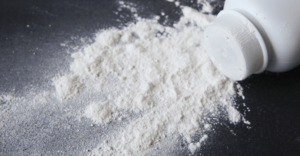Can Asbestos Cause Ovarian Cancer?

Yes, multiple studies have found a connection between asbestos exposure and the development of ovarian cancer.
Most recently, the National Institutes of Health (NIH) determined that women who used talc-based hygiene products have a higher ovarian cancer incidence.
“Despite challenges in assessing [asbestos] exposure history and biases inherent in retrospective data, our findings are robust, showing a consistent association between genital talc use and ovarian cancer.”
–Dr. Katie O’Brien, epidemiologist & lead study author
They determined the risk was higher for those who used talcum powder often or for many years. The greater the frequency or duration of use, the greater the risk.
The NIH study, published in the Journal of Clinical Oncology in May 2024, tracked over 50,000 women in the U.S. who had a sister diagnosed with breast cancer, which boosted their chances of developing breast or ovarian cancer.
Asbestos Ovarian Cancer Overview
While there are different ways to be exposed to asbestos, many ovarian cancer patients have attributed their cancer to talc-based powders, like talcum powder and baby powder.
Key Facts About Ovarian Cancer and Asbestos
- The International Agency for Research on Cancer (IARC) considers asbestos exposure a known cause of ovarian cancer.
- Consumer products such as baby powder, talcum powder, and makeup have been found to be contaminated with asbestos.
- Brands of talc powder linked to ovarian cancer include Johnson’s® Baby Powder, Shower to Shower®, and Gold Bond®.
- Patients may be entitled to compensation for asbestos-caused ovarian cancer.
If you or someone you love has been diagnosed with asbestos ovarian cancer, our team is here to help. Get a free asbestos disease case review to see if you may be eligible for financial assistance for ovarian cancer.
What Talc Products Contain Asbestos?
For decades, products like talcum powder, baby powder, and dusting powder were made from talc, a mineral that is often found near asbestos deposits, which can lead to contamination during mining.
Some talc manufacturers knew their products were contaminated with asbestos but failed to warn consumers to protect their profits.
Talc products linked to asbestos and ovarian cancer include:
- Avon® Skin So Soft Satin Talc Powder
- Cashmere Bouquet® talcum powder
- Desert Flower® talcum powder
- Johnson’s® Baby Powder
- Johnson & Johnson’s Shower to Shower® absorbent body powder
Get our Free Asbestos Product Guide to learn about everyday products that put consumers at risk.
Lawsuits for Asbestos Exposure and Ovarian Cancer
As of July 2025, over 63,000 talcum powder lawsuits have been filed against Johnson & Johnson (J&J). While talc manufacturers maintain their products are safe, they’ve already paid billions of dollars in asbestos settlements and trial verdicts to victims.
In July 2025, a Massachusetts jury awarded $8 million to an 84-year-old woman diagnosed with mesothelioma after decades of using Johnson & Johnson’s talcum powder.
Other notable asbestos ovarian cancer settlement and verdict payouts include:
- $2.1 billion for 22 women who filed an ovarian cancer and asbestos class action lawsuit
- $417 million to a California woman who used Johnson’s Baby Powder for decades
- $110 million on behalf of a long-term talc product user
- $72 million to the family of a woman who passed away from ovarian cancer
- $70 million for a J&J talc asbestos-talc cancer victim
- $55 million on behalf of a woman diagnosed with ovarian cancer
It’s not too late to take legal action and seek compensation for asbestos ovarian cancer. Take the first step toward justice with a free asbestos case review.
Other Ways Asbestos May Cause Ovarian Cancer
Women may be exposed to asbestos in ways other than through contaminated talc and develop an asbestos-related disease like ovarian cancer, mesothelioma, or lung cancer.
Other risk factors for asbestos exposure and ovarian cancer include:
- Occupational exposure: Asbestos-related diseases have developed in women who worked in factories or other industrial settings or within older or damaged buildings. Asbestos textile workers and anyone who worked around raw talc are especially at risk of occupational exposure to asbestos and ovarian cancer.
- Home exposure: Private residences, public buildings, and other structures built before the 1980s likely contained many asbestos products, like asbestos cement, insulation, and tiles. When these buildings were in poor condition or underwent repair, asbestos fibers may have been released into the air.
- Environmental exposure: There are several natural asbestos deposits across the U.S. Mining these sites can cause asbestos dust to be released into the area, posing a danger to public health.
- Secondary exposure: It’s possible to come in contact with asbestos from fibers that family members unknowingly brought home on their hair or clothing. Women may have been exposed when they did the laundry or hugged a loved one.
Asbestos lawyers have resources they can use to help victims figure out how, when, and where they were exposed to asbestos.
Symptoms of Asbestos Ovarian Cancer
The symptoms of asbestos ovarian cancer differ depending on the person and their cancer’s stage. The disease is often difficult to detect when it’s in an early stage since the symptoms are vague and associated with other common health conditions.
Signs of asbestos ovarian cancer include:
- Abnormal discharge or bleeding after menopause
- Bloating or feeling swollen in the stomach
- Constipation or diarrhea
- Fatigue
- Feeling full soon after eating
- Needing to urinate frequently
- Pain or tenderness in the abdomen, lower back, or pelvic area
- Unexplained weight loss
About 50% of women diagnosed with ovarian cancer are 63 years or older.
Ovarian cancer can be difficult to detect when it’s in an early stage since the symptoms are vague and associated with other common health conditions.
If you’re experiencing any of the symptoms listed above, consider getting checked out by your doctor as soon as possible.
Asbestos Ovarian Cancer Treatment
After an ovarian cancer diagnosis, your cancer care team will come up with a personalized treatment plan based on your cancer stage, overall health, and other factors.
Treatment options for asbestos ovarian cancer include:
- Chemotherapy
- Hormone therapy
- Immunotherapy
- Radiation
- Surgery
- Targeted therapy
Treatments can help patients relieve symptoms and even beat this cancer. When diagnosed at an early stage, about 93% of women are still alive 5 years later, compared to 75% of patients diagnosed at an intermediate stage.
Get Help for Asbestos Ovarian Cancer
For decades, asbestos in talcum powder and other consumer goods put millions of innocent women in harm’s way. As a result, many women are being diagnosed with asbestos ovarian cancer today.
Mesothelioma Hope is here to support you during this challenging time. Our Patient Advocates can help you explore your legal options and connect you with emotional support after an asbestos ovarian cancer diagnosis.
Call (866) 608-8933 or request a Free Asbestos Case Review to see if you may be eligible for financial assistance.
Asbestos Ovarian Cancer FAQs
Can you get ovarian cancer from asbestos?
Yes, it’s possible to develop ovarian cancer from asbestos exposure.
Multiple studies have concluded that women exposed to asbestos through contaminated talcum powder and in occupational settings face an increased risk of ovarian cancer.
How does asbestos cause ovarian cancer?
While the exact disease process is unknown, scientists believe that microscopic asbestos fibers can build up in ovarian tissues, resulting in inflammation, cell damage, and eventually cancer.
When women use talcum powder or baby powder that has been contaminated with asbestos in the genital area, the microscopic asbestos fibers may travel through the reproductive system to the ovaries.
What two illnesses are associated with asbestos exposure?
Ovarian cancer and mesothelioma, among other health conditions, have been linked to asbestos exposure. When people come in contact with asbestos, the tiny fibers can become lodged in the body and result in genetic mutations years later that cause cancerous tumors to form.
The two most common types of mesothelioma are pleural mesothelioma, which affects the pleura (lining of the lungs), and peritoneal mesothelioma, which affects the peritoneum (abdominal lining).
The most common type of ovarian cancer is epithelial ovarian carcinoma, which develops on the outside of the ovary. Some cases of ovarian cancer are misdiagnosed as peritoneal mesothelioma since the symptoms are similar.
Which patient has a very high risk for developing ovarian cancer?
Women who regularly used talc-based talcum powders and baby powders are at an increased risk of ovarian cancer.
One study found that women who used cosmetic talc products as part of their feminine hygiene routine were 33% more likely to develop ovarian cancer.




